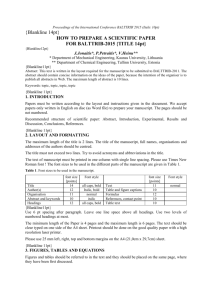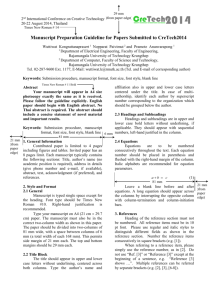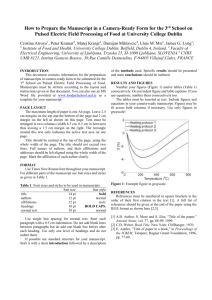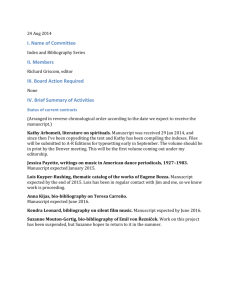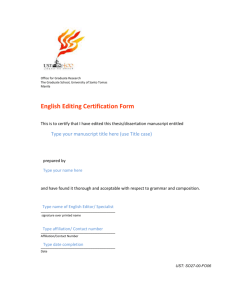MANUSCRIPT PREPARATION INSTRUCTIONS
advertisement
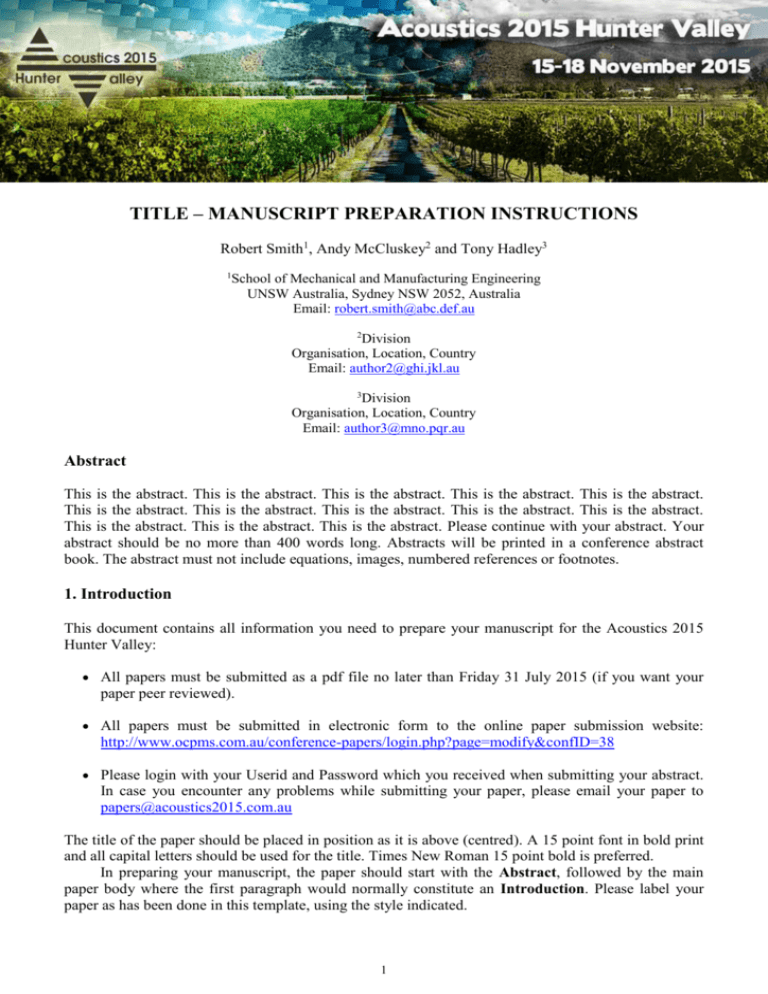
TITLE – MANUSCRIPT PREPARATION INSTRUCTIONS Robert Smith1, Andy McCluskey2 and Tony Hadley3 1 School of Mechanical and Manufacturing Engineering UNSW Australia, Sydney NSW 2052, Australia Email: robert.smith@abc.def.au 2 Division Organisation, Location, Country Email: author2@ghi.jkl.au 3 Division Organisation, Location, Country Email: author3@mno.pqr.au Abstract This is the abstract. This is the abstract. This is the abstract. This is the abstract. This is the abstract. This is the abstract. This is the abstract. This is the abstract. This is the abstract. This is the abstract. This is the abstract. This is the abstract. This is the abstract. Please continue with your abstract. Your abstract should be no more than 400 words long. Abstracts will be printed in a conference abstract book. The abstract must not include equations, images, numbered references or footnotes. 1. Introduction This document contains all information you need to prepare your manuscript for the Acoustics 2015 Hunter Valley: All papers must be submitted as a pdf file no later than Friday 31 July 2015 (if you want your paper peer reviewed). All papers must be submitted in electronic form to the online paper submission website: http://www.ocpms.com.au/conference-papers/login.php?page=modify&confID=38 Please login with your Userid and Password which you received when submitting your abstract. In case you encounter any problems while submitting your paper, please email your paper to papers@acoustics2015.com.au The title of the paper should be placed in position as it is above (centred). A 15 point font in bold print and all capital letters should be used for the title. Times New Roman 15 point bold is preferred. In preparing your manuscript, the paper should start with the Abstract, followed by the main paper body where the first paragraph would normally constitute an Introduction. Please label your paper as has been done in this template, using the style indicated. 1 2. Preparing Your Manuscript These instructions are written in a form that satisfies all of the formatting requirements for your manuscript. Please use them as a template in preparing your manuscript. Authors must take special care to follow these instructions concerning margins. The basic instructions are simple: Manuscript is formatted for an A4 size page. Your manuscript must include the Acoustics 2015 Hunter Valley logo on the first page as in this template. The text shall have both the left and right margins justified. The top margin is 1.7 cm. The bottom margin 1.5 cm Left and right margins of 1.75 cm. 3. Type Fonts and Style The manuscript must be typed single spacing. Use extra line spacings between equations, illustrations, figures and tables. The body of the text should be prepared using Times New Roman. This paragraph has been typed using Times New Roman 12 point type. It is an attractive font and easy to read. The font size used for preparation of your manuscript must be 12 point except for major section headings (13 point), figure and table captions (12 point) and references (10, 11 or 12 point). The first paragraph following a heading should not be indented. The following paragraphs must be indented 10 mm. Note that there is no line spacing between paragraphs (unless a subheading is used; see below). 4. Section Headings Section headings should be numbered and left justified. The type, fonts and style above (Times New Roman 13 point bold) are an example of a section heading. Do not underline section headings. A bold font should be used for section headings. 4.1 Subheadings Subheadings should be positioned at the left margin, in a bold-faced font the same size as the main text (Times New Roman 12 point) with single line spacing above and below. Only the first letter of each word in the subheading should be capitalized. 4.1.1 Sub-subheadings Sub-subheadings should be typed using italic font the same size as that used for the body of the text (Times New Roman 12 point italics). Only the first letter in the subheading should be capitalized. Note that a blank line precedes and follows the subheading. 5. Other Important Instructions Regarding Your Manuscript Your manuscript will have an attractive layout if you follow the style-related instructions given above. There are several other instructions that should be carefully followed: 2 5.1 Number of pages The manuscript should not exceed a maximum of 10 pages in length. 5.2 Proofreading Proofread your manuscript carefully. You are responsible for proofreading and correcting your manuscript before submitting it for publication. 5.3 Equations Equations should be left justified and equation numbers should be right justified on the page and numbered consecutively beginning with (1). Equations should be separated from the body text by a single line of spacing, before and after. 𝑝(𝐑) = − ∫𝑆 (𝑝𝑠 𝑔(|𝐑 − 𝐑 0 |) = 𝜕𝑔(|𝐑−𝐑 0 |) 𝜕𝜉 + 𝜌𝑓 𝑤̈ 𝑔(|𝐑 − 𝐑 0 |)) 𝑑𝑆(𝐑 0 ) 𝑗𝑘 |𝐑−𝐑0 | −𝑒 𝑓 4𝜋|𝐑−𝐑 0 | (1) (2) 5.4 Units The use of SI units is required. 5.5 Tables Tables should have a border. Table captions are 12 point Times New Roman font. Table captions should always be positioned above the table (see example on the next page). Captions should be centred. 5.6 Figures All figures must be individually numbered and captioned. Illustrations must be sharp and clear, including any lettering on the figure. Figure captions are 12 point Times New Roman font. These captions should always be positioned below the figure. Captions should be centred. 5.7 Location of illustrations and size of lettering The illustrations should be located within the text material. The illustrations should be legible with labels of a sufficient size. 6. Conclusions Following the body of the paper, the last section is normally the Conclusions or Summary and should be labelled as such. Acknowledgements This section is to thank those who helped you complete this work or to thank the funding agency for your work. This section should not have a section number. 3 Table 1. Cylindrical hull parameters Parameter Value Diameter, d (m) Thickness, h (mm) Length, L (m) Young’s modulus, E (GPa) Density, (kg/m3) 6.5 45 45 200 7800 0.3 Poisson’s ratio, v Figure 1. Finite element model of a 5×5 sonic crystal lattice using solid circular cylindrical scatterers under incident plane wave excitation Figure 2. Insertion loss for a 5×5 square lattice sonic crystal barrier 4 References The reference heading should not be numbered. To save space, references may be set in 10, 11 or 12 point type. 10 point is the smallest type that should be used for references. All references should appear at the end of the paper. An example of the proper format for references is given below. The title of the journal, book or conference proceedings should be in italics. The volume number of a journal paper should be printed using a boldface font. For citations in the text please use square brackets and numbers, that is, [1], [2]. The numbering of references should be in ascending order. [1] Ingard, K.U. “On the theory and design of acoustic resonators”, Journal of the Acoustical Society of America, 25, 1037-1067, (1953). [2] Leissa, A.W. Vibration of shells, American Institute of Physics, Woodbury, New York, 1993. [3] Junger M.C. and Feit, D. Sound, structures and their interaction, MIT Press, 1985. [4] Pan, J., Farag, N., Lin T. and Juniper, R. “Propeller induced structural vibration through the thrust bearing”, Proceedings of Acoustics 2002, Adelaide, Australia, 13-15 November 2002, pp. 390-399. [5] Campos L.M.B.C. and Oliveira, J.M.G.S. “On sound generation in cylindrical nozzles with nonuniform impedance”, Proceedings of the Twelfth International Congress on Sound and Vibration (ICSV12), Lisbon, Portugal, 11-14 July 2005. [6] Saunders, R.E., Samuels, S.E., Leach R. and Hall, A. “An evaluation of the UK DoE traffic noise prediction method”, Australian Road Research Board, Research Report, Melbourne, 1983. [7] Kinsler, L.E., Frey, A.R., Coppens, A.B. and Sanders, J.V. Fundamentals of Acoustics, 4th edition, Wiley, New York, 2000. [8] AS/NZS 1270:2002 Acoustics – Hearing protectors, 5th edition, Standards Australia, Sydney, Australia, 2002. [9] ISO 8253-1:2010 Acoustics - Audiometric test methods - Part 1: Pure-tone air and bone conduction audiometry, International Organization for Standardization, Geneva, Switzerland, 2010. Submission Deadlines Manuscripts for peer review must be uploaded as a pdf file not later than 31 July 2015. Manuscripts which are not required to be peer reviewed must be uploaded as a pdf file not later than 30 September 2015. Please submit your complete paper in pdf format using the online paper submission website: http://www.acoustics.asn.au/conference-papers/login.php Please login with your Userid and Password which you received when submitting your abstract. This is the preferred form of paper submission. Authors may also send their paper by email to: papers@acoustics2015.com.au Presentation Each presentation will be 20 minutes in total (15 minutes for the presentation, 3 minutes for questions and 2 minutes for changeover). Make sure that you stay within these time limits. 5


